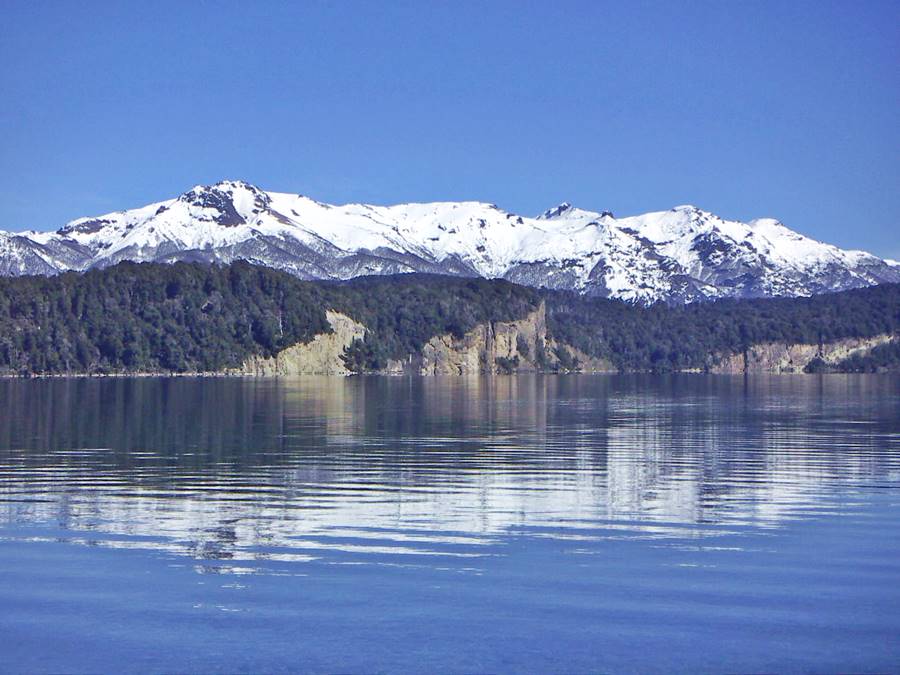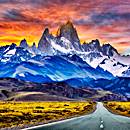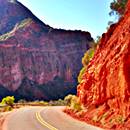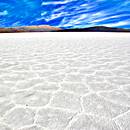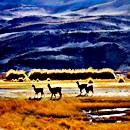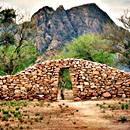Top 10 of Ruta 40
Seven Lakes Tour Guide
"One of the best 10 Scenic Drives of Argentina's Ruta 40"
Mile-by-Mile itinerary along the Road of the Seven Lakes
This is a scenic highway running through the seven lakes district in Argentina, with great views of the forests, snow-melt rivers and streams, the snow capped Andes and of course the "Seven Lakes" in the Nahuel Huapi and Lanín National Parks in Patagonia.
It is actually a section of the legendary Ruta Nacional 40, linking the cities of Bariloche and Dina Huapi in Río Negro province, with Villa La Angostura and San Martín de los Andes in Neuquén province.
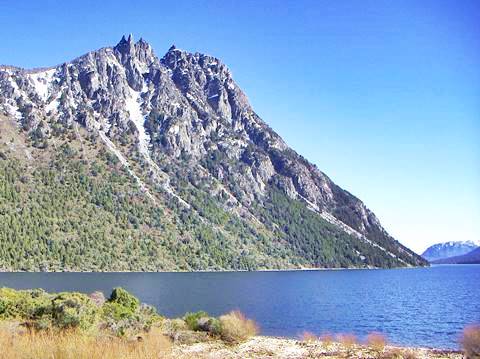
Which are these "Seven" Lakes?
There are many versions about which lakes are "the" seven lakes that give this scenic highway its name (this is because there are more than seven lakes along the tour).
In our website, the Seven Lakes are the following (from South to North):
How many lakes are there?
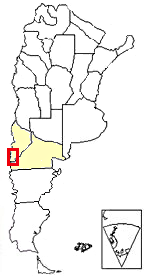
Ruta de los Siete Lagos is located in southern Argentina, see red box in this map
There are plenty of lists with the "seven lakes" and each author has his own choices. Let's see some of the options:
Lucioni, Josifovich and Cancela (1974), removed the Escondido and added the Hermoso. Erize (1991), took out the Machónico and added the Espejo Chico.
Florian von der Fecht (2005), added both Traful and Hermoso and de-listed Nahuel Huapi and Escondido. Pablo Cousido (2006), included the Hermoso and Espejo Chico but eliminated the Escondido and Machónico. Han Honders (2012) coincides with us.
The point is that there are more than seven lakes, and apart from those listed above, you can also include the following ones:
And, very close to the Ruta 40 are another two large lakes:
- Lake Meliquina
- Lake Lolog
Don't mistake Argentina's Seven Lakes District for Chile's Seven Lakes
These are a group of lakes along the Lacar Lake drainage basin; it is a volcanic area and the lakes are the following: Panguipulli, Calafquen, Riñihue, Pirihueico, Neltume, Pellaifa and Pullinque.
After completing the Ruta de los Siete Lagos in Argentina in San Martin de los Andes, you can head to the western tip of Lake Lacar at Hua Hum and enter Chile there to do their circuit.
Description of the Ruta de los Siete Lagos Tour
Note: Its Spanish name "Ruta de los Siete Lagos" literally means "Seven Lakes Route". Also known as "Camino de los Siete Lagos" ("Seven Lakes Road").
It spans 191 km (119 miles) of fully paved highway (tw lanes: one going, one coming), running from Bariloche to San Martín de los Andes.
You can drive back along the same road in a round trip, or opt for a longer but very scenic circuit (260 km - 162 mi), heading north along Ruta 40 through Junín de los Andes and then at La Rinconada, head south along Ruta Nacional 234 and 237, in the Andean foothills and the Patagonian steppe, in the Collón Cura and Limay River Valleys, through the Enchanted Valley (Valle Encantado). This is a paved highway.
Leave Bariloche...
From Bariloche to the Limay River Valley
Depart from Bariloche (km 0) and take the Juan M. de Rosas Ave. east. The avenue meets Ruta 40 just by the Ñireco River bridge inside the city.
The highway passes by the old railroad station and the Bus Terminal. At km 7,5 Highway police checkpoint -drop your speed, followed by the roundabout that leads to Bariloche's International Airport. Take the last exit and keep on coasting Lake Nahuel Huapi, to your left.
At km 9 sharp left curve and grade crossing across the railroad tracks, followed by a sharp right turn. The road then heads towards the inflowing Ñirihuau River (km 13).
The vegetation is becoming thinner, the forest can be seen on the distant mountains, but by the highway it is steppe-like: low bushes and shrubs adapted to the strong Patagonian winds.
To the west you have a panoramic view of the city of Bariloche, and behind it the Andes, with the peaks of the Ventana, Otto, Catedral, Goye, López, Capilla and Millaqueo Mountains. A good view of the San Pedro Peninsula, and if the day is clear, you can see the glacier capped Cerro Tronador Mountain (3,554 m high - 11,652 ft).
>> Find your hotel in Bariloche
Bariloche
Full details on the town of > > Bariloche [our Spanish language webpage]
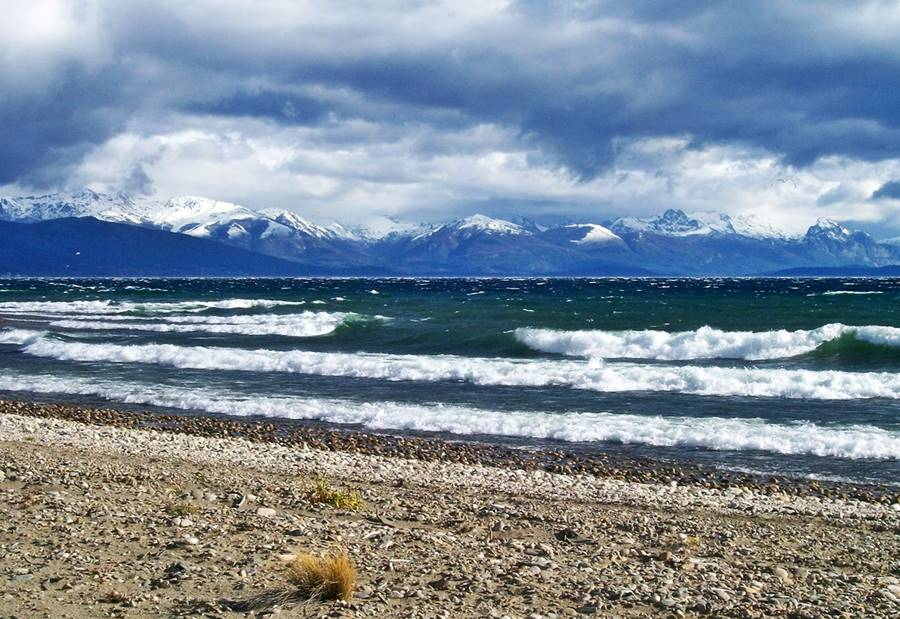
Dina Huapi
At km 13,5 you reach the small town of Dina Huapi.
Its name combines "Dina" from "Dinamarca" (Spanish for Denmark) after the first settlers who came from that country, and the Mapuche word Huapi which means "island".
At the northern tip of the town (km 15,7) Ruta Nacional 23 forks off to the right, to cross the Patagonian steppe all the way to the provincial capital of Viedma, close to the Atlantic Ocean.
>> Find your hotel in Dina Huapi
Dina Huapi
Full details on the town of > > Dina Huapi [our Spanish language webpage]
Neuquén Province
Just ahead is the Limay River, the outlet of Lake Nahuel Huapi. It marks the border between Río Negro and Neuqué provinces. The Limay flows into the Negro River and the lake's water reaches the Atlantic Ocean.
Cross the bridge (km 17,7) and slow down at the police checkpoint in this place known as Nahuel Huapi.
Th road climbs the glacial morraine that marks the eatern tip of the lake and at km 19 is a Historic Site:
Flag-raising Monument
It was here that Argentine explorer Francisco P. Moreno hoisted the Argentine flag for the first time in the Patagonian Lake District: he did so on January 22, 1876. A great view of Bariloche and the Andes, there is a parking area.

Bariloche Junction
After the monumento, the road climbs, crosses the terminal morraine and enters the Limay River Valley, which here is quite wide and rather flat.
At km 20,5 a "T" junction. Ruta 40 turns left towards Villa La Angostura heading west, and Ruta Nacional 237 runs north towards the Valle in cantado (Enchanted Valley).
Across the Steppe and the transition zone of the Andean Forests
Important
Be alert. There are many heavy semi-trailer trucks on this road, most of them Chilean trucks, that use Ruta 40 to link the southern tip of Chile with Central Chile (which are cut off from each other by the fjords south of Puerto Montt.
Turn west along Ruta 40, which runs along Lake Nahuel Huapi's norhtern side, far from the shore. The countryside is initially a shrubland (steppe) but as you drive west (and rainfall increases), cypress, radal and maiten trees appear and, by the time you reach Puerto Coihue on the southwestern tip of the Huemul Arm of Lake Nahuel Huapi, it has become a forest.
Between mileposts km 2170 and 2173 there are some places with a view across the lake towards the south, facing Bariloche. Close to this point Father Mascardi established the Jesuit Mission of Nahuel Huapi in 1670, but shortly after he was murdered by the natives. The mission was finally abandoned in 1717.
Lake Nahuel Huapi
First Lake
This lake is the home of the mythical lake creature known as "Nahuelito".
Spanish conquistador Juan Fernández explored the area in 1621 and discovered a "very large lagoon known as Navalhuapi". The name means "Tiger Island" ("Nahuel" is the Mapuche word for "jaguar", and "Huapi" is "island".
Jesuit priest Diego de Rosales wrote in 1653 after exploring the region that "Nahuelhuapi... means: Lagoon of tigers" and added that it was inhabited by "Rebel indians" that "were called tigers because of their bravery", so the jaguars were the natives and not the big cats. Nevertheless, jaguars did live in Patagonia until the quite recently.
El lake covers 550 km2 (212 sq.mi.) and is shared by Neuquén and Río Negro provinces. It has several fjord-like arms, excavated by glaciers: Blest, Tristeza, Huemul, Machete, etc.
Through the Forest towards Villa La Angostura
At km 43 the Seven Lakes Route enters the Andean forests, on the western tip of the Huemul Arm (named after the endangered Patagonian deer Hippocamelus bisulcus); the highway runs along its northeastern coast. At km 50 a camping area on the lake shore. At km 52 is the traditional Santa María Inn.
After a "U" shaped section to cross the Huemul River, the road then reaches the main body of the lake at km 60, site of a serious rock fall in July 2019 that cut the highway for several days.
It crosses Ragintuco stream at km 66. To the west you can see isla Victoria Island and further north is Quetrihué Peninsula, which is part of the Parque Nacional Arrayanes National Park -the "Arrayan" is a unique Patagonian Tree, with soft "latte-colored" bark, which is a member of the Myrtle tree family.
At km 76 road to the left into the tourist complex at Bahía Manzano. There are more buildings along the road as you approach Villa La Angostura.
Country Club Cumelén (km 78) and to your right, just ahead is the road leading to the Cerro Bayo ski resort. There is a lookout on the mountain 9 km uphill, with a great panoramic view of the area.

Villa La Angostura
The Road of the Seven Lakes reaches the neat town (km 84), this district is known as "El Cruce" (Crossroads) and is the commercial district ofe Villa La Angostura: you can eat, buy souvenirs, groceries, fill up your gas tank and enjoy the town.
You can take a short trip (3 km) to the original village at "La Angostura" (which means "The Narrows"), due to the narrow strip of land or isthmus less than 100 yards wide, that links the Quetrihue Peninsula with the mainland. There are sandy beaches, some stores and a pier.
>> Find your hotel in Villa la Angostura
Villa Angostura
Full details on the town of > > Villa Angostura [our Spanish language webpage]
The gas station at El Cruce is the last one. No more service stations until you reach San Martín de los Andes, 107 km away.
From "El Cruce" take the Seven Lakes Highway northbound (right), just 3.5 km ahead, and 500 yards before the bridge across the Correntoso River, take the "Cacique Antriao" street, to your left and drive towards the river, it will take you to the southern tip of Lake Correntoso. There you have a wide sandy beach and you can visit the old wooden bridge built in the 1930s, that spans the Correntoso River.
Correntoso River
It is, as its Spanish name implies, (Correntoso means "river with a strong current") a swift flowing river and it claims to be "the shortest river in the World". It is a great fly-fishing spot for trout.
Lake Correntoso
Second Lake
Eduardo O'Connor named it "Lake Frías" in 1884 and called the river "río de la Cerveza" (Beer River) because they had wagered a box of beer that there was a river there. Ramón Lista named it río Correntoso in 1894 and the lake took its name from the river.
It has an area of 25 km2 (9.7 sq.mi.) and a north-south alignment it is narrow, deep and calm.
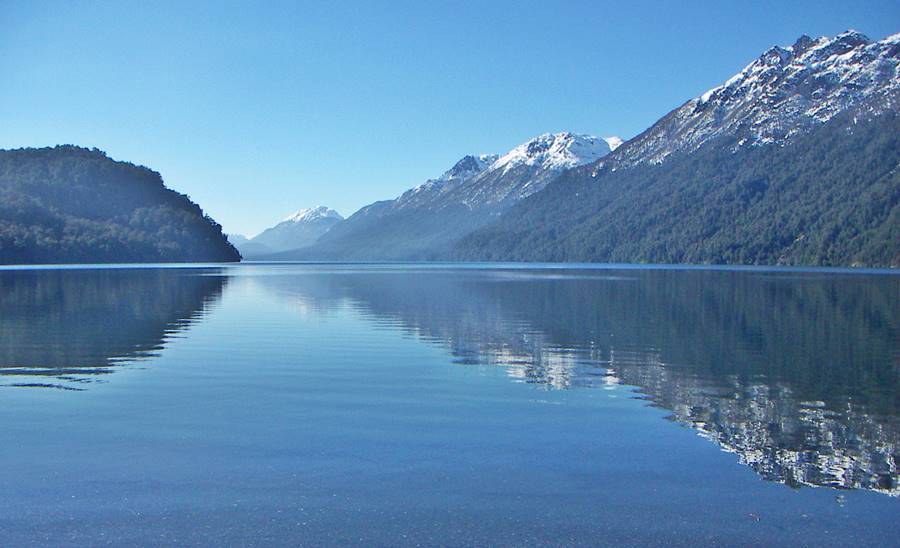
Head back to the Seven lakes circuit by retracing your steps and head north, cross the Correntoso River along the modern concrete bridge. To your left is the classic Correntoso Hotel. The road now runs along the Última Esperanza Arm (Spanish for "Last Hope") of Lake Nahuel Huapi and there are some good spots along the road with a view of the lake and the Andes.
Fork of Ruta 231 and Ruta 40
At km 95 the Seven Lakes Route reaches a fork:
- West (keep going straight) is Argentina's National Highway 231 (Ruta Nacional 231) which heads into the Andes towards the Cardenal Samoré Pass on the Chilean border.
- North (turn right) is Ruta 40 and the Seven Lakes Road.
Lake Espejo Scenic Lookout
Tip: Drive another 600 m along Ruta Nacional 231, and to your right is the Espejo Lake Lookout. You can see the lake below and the "Cerro Cuerno" (Mount Horn) (1.658 m - 5,436 ft). There is a parking area - don't park on the road or shoulder it is dangerous.
Cardinal Antonio Samoré International Border Crossing
Learn more about this border Crossing: Paso Internacional Cardenal Samoré
Return to the junction and head north along Ruta 40.
Lake Espejo
Third Lake
Its name means "mirror" in Spanish, and it is due to it being a deep and calm lake. It covers an area of 44 km2 (17 sq. mi.)
The Seven Lakes Road passis by its southern tip, where there is a beach and a campbground. And, at km 101 by its eastern tip, where there is another camping area.
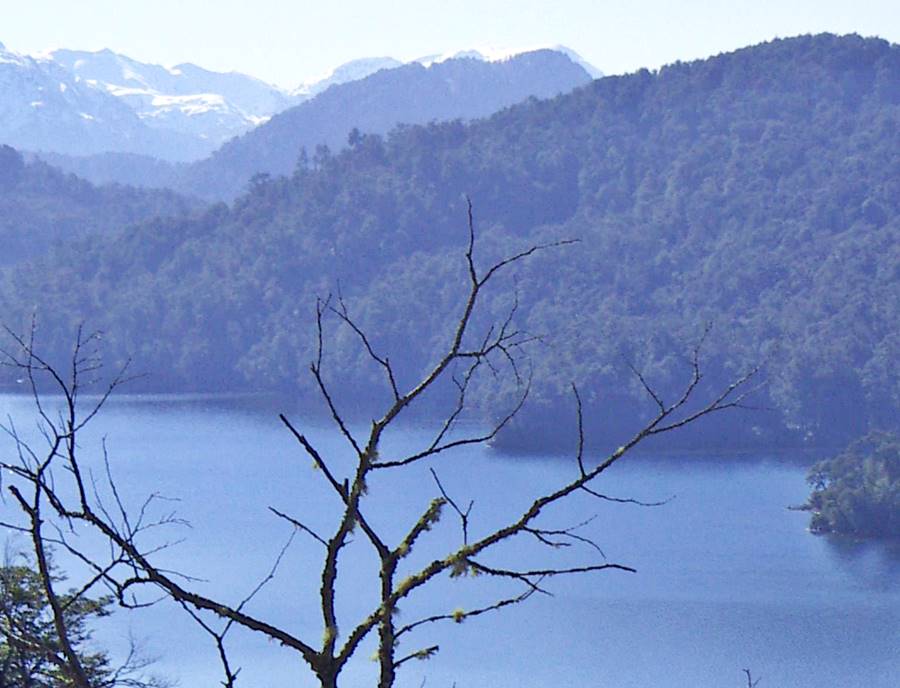
The road has a northbound course with Lake Correntoso hidden behind the forested hills, to your right. At km 103 is the Bailey Willis Lake to your left.
Lake Bailey Willis
Named after an American engineer who worked for the Argentine government between 1910 and 1914 studying the alignment of a projected railroad -never built- in the region.
It is a tiny (30 ha. - 74 acre) lake shaped like a triangle only 1 km long (0.6 mi).
Ahead (km 106) the Seven Lakes Route reaches the northern tip of Lake Correntoso at a place known as Ruca Malén (House of the Maiden in Mapuche language), here are the remains of the former hotel and the old and now abandoned wooden bridge over the river that is the outflow of the Espejo Chico Lake. Just past the hotel is a road (left) that leads to the small lake which is only 2 km away.
Lake Espejo Chico
It's name means "Small Mirror Lake" it receives the outflow of Lago Espejo. It is 3.4 km long and 1.2 km wide and covers an area of 170 ha. (420 acres).
Quintupuray
The road hugs the Correntoso's norhtern shore and passes through Quintupuray (km 112), take the detour along the old dirt road down to the place. There is a small hotel and farm there with a campground and it is a great spot for a picnic. It is named after the Mapuche family that settled there in the early 1900s.
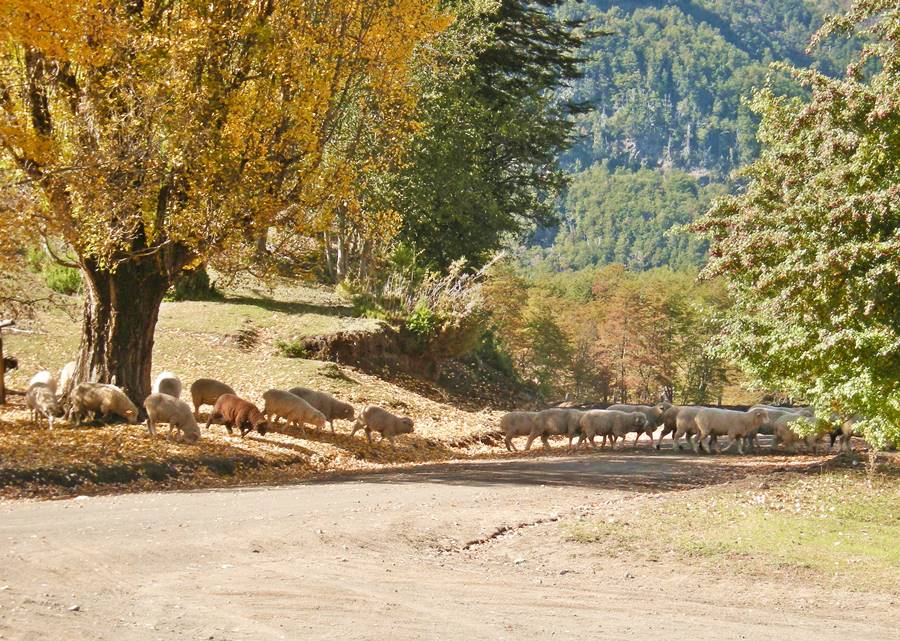
Road to Villa Traful
The road leaves Lake Correntoso at Quintupuray, turns north and climbs into the mountains. At km 115 junction with Provincial Highway 65 -dirt and gravel- which forks off towards the east (right) to cross the Portezuelo Pass (elev. 1.000 m - 3,279 ft.) and leads to Lake Traful and the pictouresque village of Villa Traful.
>> Find your hotel in Villa Traful
Villa Traful
Full details on the town of > > Villa Traful [our Spanish language webpage]
Circuito Grande - Big Circuit
This is a tourist circuit that follows Ruta de los Siete Lagos to this point and heads through Villa Traful, passes the amazing lookout of "Mirador del lago Traful" and at Confluencia (after 59 km along the gravel Prov. Hwy. 65), reaches paved Ruta Nac. 237 in the Valle Encantado (Enchanted Valley), here you drive back to Bariloche along the Limay River Valley.
7 Lakes Road towards Pichi Traful
Leaving the junction behind, head north along Ruta 40 into the Neuquencó River Valley, the road climbs to its headwaters (1.030 m - 3,377 ft.) at km 124 and then descends along the Pichi Traful River Valley, there are several pacew where you can access the river along the way.
Youo reach the site of the old Pichi Traful Hotel (km 135) on the northwestern tip of Lake Traful. To your right is a narrow road leading to it, 2 km long.
Lake Traful
It is the second largest lake in the Nahuel Huapi National Park. Its name, in Mapuche means "where the rivers meet", a reference to the confluence of the Traful and Limay Rivers, downstream.
It is located at a height of 808 m (2,649 ft.) and has a surface area of 75 km2 (29 sq. mi.). By the way, "Pichi" in Mapuche means "small".
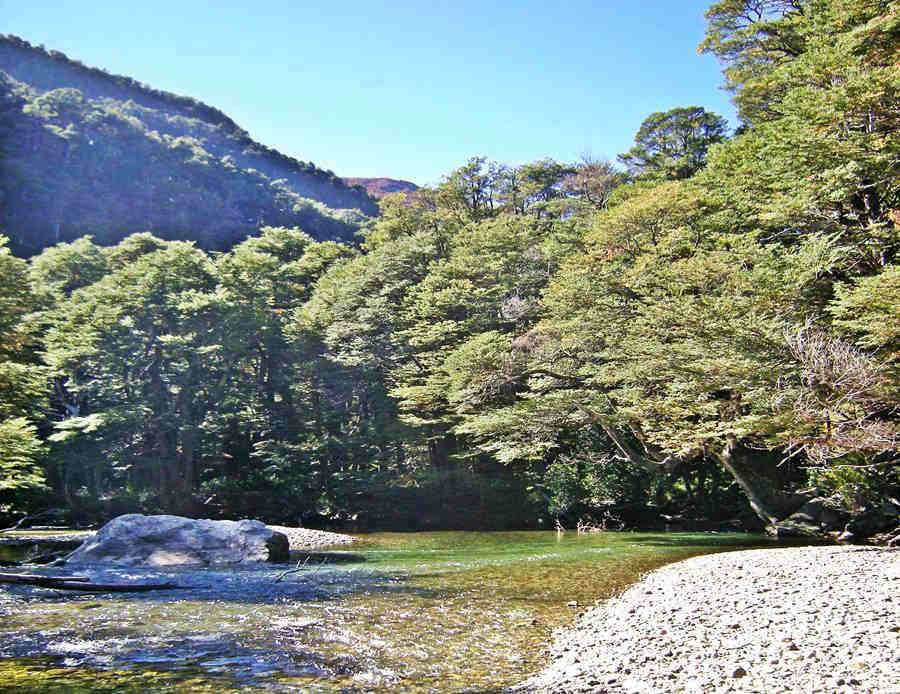
Not far ahead, in a deep valley to your left is the almost invisible Lake Escondido (km 139), concealed by the forest:
El Lake Escondido
Fourth Lake
Its name means "Hidden" and it is appropriate because it is hidden in the dense forest. It is minute, an oval 850 m long and 250 m wide (roughly 930 yds. by 270 yds).

Return to your Seven Lakes Tour: right after lago Escondido, at km 140 you have a great view of Lake Villarino (alt. 932 m - 3,056 ft).
Lakes Villarino and Falkner
The road heads down and at km 143 reaches the plain at the base of the valley that links both lakes: Lake Villarino (West) and Lake Falkner (East), a short 300 yard-long river joins both lakes.
Here is Lake Villarino Lodge and a campground.
Lakes Falkner and Vilarino
Fifth and Sixth Lakes
The lakes have an east-west alignment. They were named after:
Thomas Falkner (1707-1784). English Jesuit who lived in what is now Argentina in seveal missions among the natives close to Patagonia from 1730 until 1767 whe the Spanish Crown expelled the Jesuits from their colonies. Back in Britain he wrote his famous book: Description of Patagonia and the adjoining parts of South America (1774).
Basilio Villarino (1741-1785), Spanish explorer and sailor who navigated the coasts of Patagonia and was the first European to sail up the Negro, Limay and Collón Curá Rivers in the 1770s.


There are beaches on both lakes and you can park on the western tip of Lake Falkner, which is an ideal place for a picnic.
Continue north, and on the left side of the Seven Lakes Highway at km 146 is the Vullinanco Waterfall (o Vulignanco) with a 20 m (66 ft) fall.
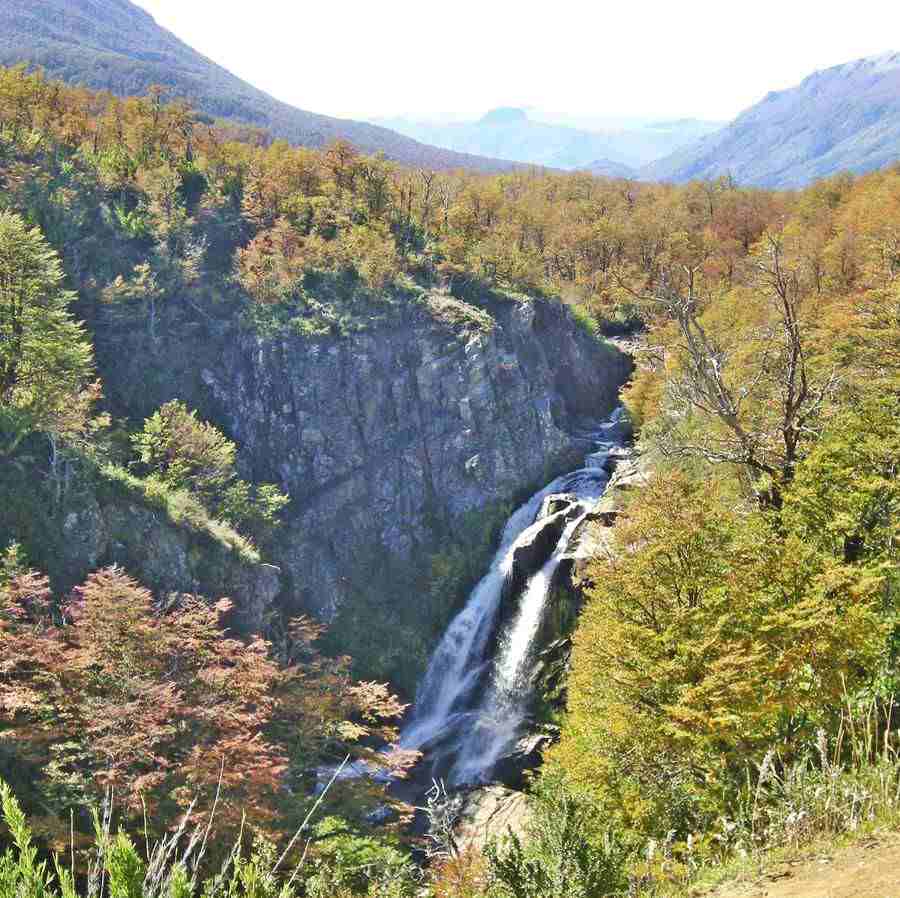
The word "Vullinanco" is a Mapuche native word and may come from their word "Ñanco": hawk.
Lakes Hermoso and Machónico
The Ruta de los Siete Lagos enters the Lanín National Park at km 150, and runs along a wide and relatively flat valley.
When you reach km 155 to your left is a road that leads to Lago Hermoso lake which is 2 km away. It passes by some cabins and a tiny lagoon (Laguna Pudu Pudu) named after the Pudu-Pudu, the smallest deer in the world, barely 1 foot tall, which lives in these forests.

Lake Hermoso
"Hermoso" in Spanish means "Beautiful", and this lake is really beautiful. You can only reach its eastern tip. It has an area of 8 km2 (3 sq. mi).
Return to your 7 lakes tour and head north.
The highway runs through an area where the forest thins out, becoming a transition zone between the Andean Subantarctic forest and the cypress forests of the dryier eastern Andes foothills.
At km 160 to your left is the last of the Seven Lakes of the "Ruta de los Siete Lagos", Lake Machónico:
Lake Machonico
The Seventh Lake
Its name comes from the Mapuche words: "Mashó": "shrimp", "ni": possessive pronoun and "kó": "water". So the combination "Mashó- ñiko" means "lake of shrimps"
Did you know that there are shrimp and also minute crabs hidden among the pebbles of the lakes in the Patagonian Lake District?
It has an area of only 1,5 km2 or 0.6 sq.mi.
Paso Córdoba Junction
At km 165 you reach the junction with Provincial Route 63 (gravel surfaced) to your right, which leads to Villa Meliquina a mountain village located 14 km east, on the eastern tip of Lake Meliquina. This higway 63 continues south all the way to the beautiful Paso Córdoba Pass and reaches Confluencia (after 67 km) in the "Valle Encantado" on the Limay River meeting paved Ruta 237 which takes you back to Bariloche.
>> Find your hotel in Villa Meliquina
Villa Lago Meliquina
Full details on the town of > > Villa Lago Meliquina [our Spanish language webpage]

Lake Meliquina
Surface area: 13 km2 (5 sq. mi.). Elevation: 850 m. (2,787 ft.) its name, in Mapuche means "Four corners" (after its rectangular shape).
The Final leg of the Seven Lakes Road
Fromo the junction with Prov. Hwy 63 the road climbs up the narrow valley of arroyo Culebra Creek, heading northwards. It reaches Pil Pil Pass - 1.280 m (4,197 ft.) at km 174,5 and there, at the bridge across the Arroyo Partido is a very odd natural landmark:
Arroyo Partido - Split Creek
This creek's waters flow into two oceans -hence its name: part flows towards the Atlantic Oceabn and part into the Pacific Ocean
At the crest of Pil Pil pass there is a small marshy grassland, known in Mapuche as a "Mallín" which marks the continental divide. To the south the water drains into the Atlantic Ocean and to the north, into the Pacific.
The road crosses the pass and the mallín, and at the summit it crosses the brige. The brook flows down from the Chapelcó Range to your right. After passing under Ruta 40, the brook splits into two prongs, adopting a "Y" shape with a northern and southern outflow. And that is why it is called "Partido" which in Spanish means "Split". Each arm flows into a different ocean:
- The South arm: is the arroyo Culebra (Culebra Creek) that descends towards the Hermoso River and reaches the Atlantic via the Limay and Negro Rivers.
- The North arm: is the arroyo Pil Pil (Pil Pil Creek) which flows through several mallines and reaches Lake Lacar and from there, crosses into Chile along the Hua Hum River, and flows through the Chilean seven lakes (mentioned at the top of the page) into the Pacific.
There is a sign and a lookout on the left side of the 7 Lakes Road.
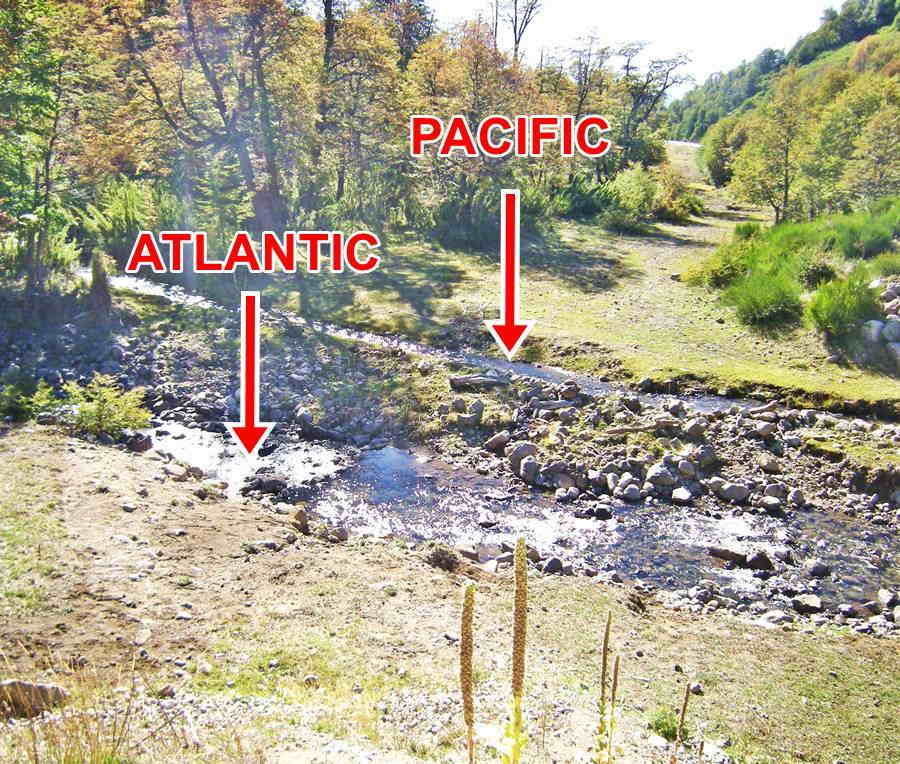
At km 177 access road to the Chapelco ski resort and at km 186 the road that leads to the Mapuche community of "Quila Quina" located on Lake Lacar's shore; it has beaches and a campground (12 km from Ruta 40). There is a carbonated water spring, rock art and a waterfall there.
One kilometer ahead is the road that leads to Playa Catritre beach on Lake Lacar:
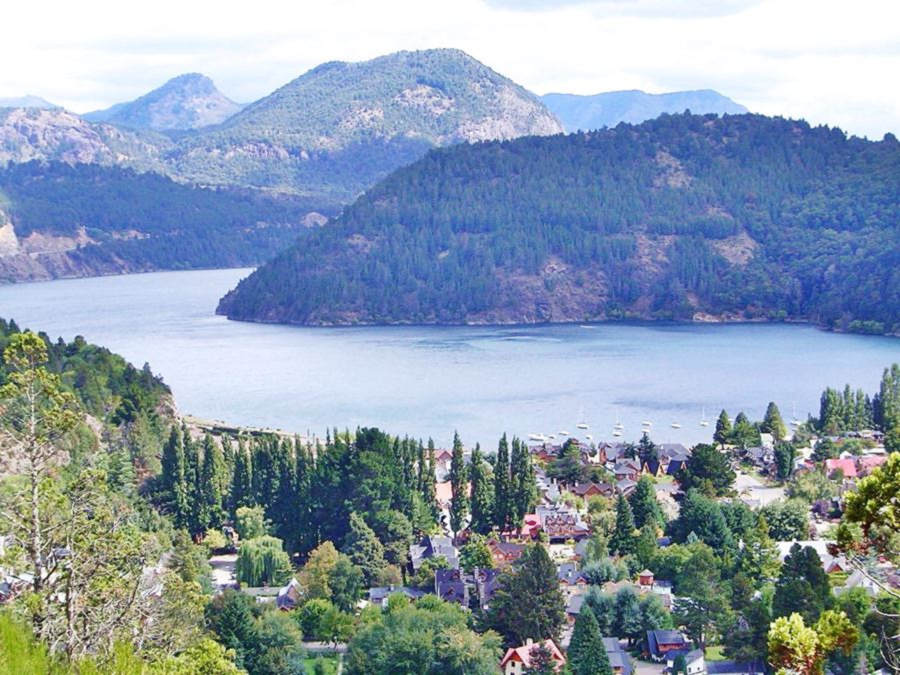
Lake Lacar
Juan Domingo Perón (Argentine President 1946-55) in his book about Patagonian toponyms wrote that the name may mean in Mapuche: "lai": "dead" y "calcu": "wizard" o sea "dead wizard".
It could also mean "lar - carcu" or "crumbling cliffs".
The lake has an East-West alignment and flows into the Pacific. It has a surface area of 49 km2 (19 sq.mi.) and a depth of 277 m (908 ft.)
San Martín de los Andes
The Seven Lakes Route runs along its southern shoreline, a steep incline cut into a sheer mountain. It reaches the town of San Martín de los Andes at km 193. The town is built on the flat valley that extends east from the lake's eastern tip.
This marks the end of your Seven Lakes Tour.
>> Find your hotel in San Martín de los Andes
San Martin de los Andes
Full details on the town of > > San Martin de los Andes [our Spanish language webpage]
Map of the Ruta de los Siete Lagos
The Seven Lakes Circuit is shwon in the map below, as well as the other roads in the region.
See this Google Map of the Road of the Seven Lakes.
Abajo una Hoja de Ruta:

Tips and Recommendations: This segment of Ruta 40
Some tips about driving in the seven lakes district in Argentina.
When to drive the Seven Lakes Circuit
The road is open year round. In winter it may snow and be blocked temporarily. In summer there are more tourists visiting the area, but the weather is better (though it can also be chilly and rain). Autumn and Spring are the low season -cheaper hotels and car rental. Winter is the ski season specially during the Argentine winter holidays (July) note that there are two ski resorts on the 7 Lakes Road: Chapelco (San Martín de los Andes) and Cerro Bayo (Villa la Angostura) as well as Catedral in Bariloche.
Road Conditions
Check out Route 40 and the Seven Lakes Road conditions in our website: Road Conditions (under Neuquen in Patagonia).
Some Advice for a safe trip
Keep your gas tank full (see where below) before setting off on any tour in Patagonia fill your gas tank. During high seasons there may be fuel shortages and queues and long delays at gas stations even in relatively large towns like Bariloche or San Martin de los Andes.
Take some warm clothes with you. Even in summer it can get cold or rain. Wind is strong and steady in Patagonia.
Even though the highway is paved, it only has one lane per side, and the shoulders are unpaved. The road is a winding highway in a forested mountain area. It has inclines and there is heavy semi-trailer truck traffic on the road, to and from Chile between Bariloche and Espejo Lake Watch out when you overtake and at the curves.
In winnter there may be ice in the shady sections, salt is not used in Argentina (some exceptions: Collon Cura incline). So the road will be slippery and you may skid or roll over.
Lighting fires in the forsts: Do not light fires unless it is permitted. Don't discard your cigarette butt in the forest. Summer is the drier season and forest fire risk increases.
There is fuel in : Bariloche, Villa La Angostura, San Martín de los Andes, Junín de los Andes and Confluencia (on Ruta 237).
› › Location of the Service Stations
The neighboring Segments of Ruta 40
Previous Segment (Esquel - Bariloche)
Current Segment (Bariloche - Zapala)
Next Segment (Zapala - Barrancas)
Accommodation near the Seven Lakes Road
>> Find your hotel in Villa la Angostura
Hotels along Ruta 40
In Neuquén, close to Ruta 40
>> Find your hotel in Neuquén Province

